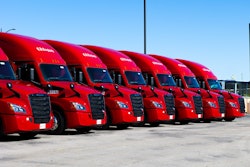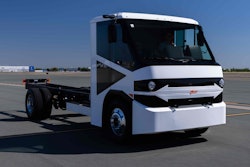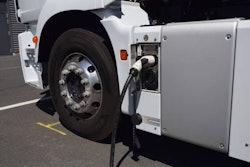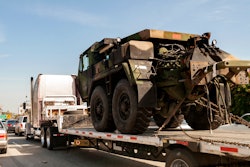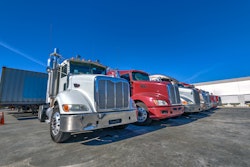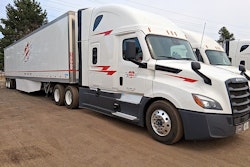The second quarter of 2025 highlighted how uneven the freight market continues to be, with big fleets navigating rising costs, soft demand, the ongoing impacts of industry overcapacity, and trade and regulations uncertainty.
Labor, maintenance, insurance, and equipment costs remained common challenges across the board. Some leaned on pricing discipline or growth in niche segments, while others reported revenue declines and losses as weaker volumes and higher expenses pressured margins.
Still, there were bright spots. Dedicated contract services, intermodal, and specialized hauling showed resilience, while some benefitted from strategic acquisitions or legal rulings that boosted financial performance.
Covenant focuses on niche services
Covenant (CCJ Top 250, No. 36) saw its operating expenses creep up, primarily due to labor and maintenance costs. Covenant President Paul Bunn noted that the increases were expected as it relates to growth in its dedicated protein supply chain business, which required hiring skilled drivers and maintenance professionals.
Truckload operations’ freight revenue grew by $2.6 million because of a 4.9% fleet increase, though it was partially offset by lower equipment utilization. Expedited segment decreased its tractors by 50 units or 5.5% compared to the prior year’s quarter and was utilized less, though it did earn slightly more per mile (+2.4%).
The dedicated segment added 162 units or 11.7%. However, utilization was down 7.7%, though it was partially offset by a 7% increase in revenue per mile. The average age of its tractors increased slightly to 22 months compared to 21 months a year ago.
Revenue: 2025 Q2: $302.8 million vs. 2024 Q2: $287 million
2025 YTD: $572 million vs. 2024 YTD: $566 million
Income: 2025 Q2: $9.84 million vs. 2024 Q2: $12 million
2025 YTD: $16.4 million vs. 2024 YTD: $16.1 million
-
Forward Air’s strategic pricing pays off
Forward Air (No. 31) saw earnings grow, despite revenue decline, citing ongoing challenges in the sector. The company noted improvements in the expedited freight segment due to cost management and pricing strategy that was implanted in the Q4 2024 and completed in the first quarter of the year. CEO Shawn Stewart said they plan to stay lean not just by cost cutting, but “really looking at improving quality of operations, not only just in service, but also in cost around revenues.”
CFO Jamie Pearson emphasized the company’s focus on leveraging existing customer relationships, adding, “We all know that the cheapest dollar to win is the customer that you already have.”
Revenue: 2025 Q2: $618.84 million vs. 2024 Q2: $634 million
2025 YTD: $1.2 billion vs. 2024 YTD: $1.1 billion
Income: 2025 Q2: $19.52 million vs. 2024 Q2: $(1.09) billion
2025 YTD: $24 million vs. 2024 YTD: $(1.16) billion
-
Heartland Express reports loss, cites market challenges
Heartland Express (No. 25) CEO Mike Gerdin said financial results reflected sequential improvement amid overcapacity, unsustainable pricing and rising operating costs. Operating ratio was also up 106.0%, up 99.4% compared to the same period last year. It also faced issues with its acquisitions, particularly Smith Transport and Contract Freighters, both of which didn’t operate profitably during the quarter.
The company is continuing its strategy of reducing “underperforming lanes of freight” and overall fleet size to align with current freight demand. The average age of its tractor fleet was 2.6 years as of June 30, 2025, similar to a year ago. The average age of its trailer fleet was 7.5 years, compared to 6.9 years on the same period last year.
Revenue: 2025 Q2: $210.4 million vs. 2024 Q2: $274.7 million
2025 YTD: $429.8 million vs. 2024 YTD: $545 million
Income: 2025 Q2: $(10.8) million vs. 2024 Q2: $(3.4) million
2025 YTD: $(24.72) million vs. 2024 YTD: $(18.58) million
-
J.B. Hunt sees intermodal growth
J.B. Hunt (No. 3) reported that revenue was flat compared to Q2 2024 at $2.93 billion. Revenue performance was driven by a 6% increase in intermodal loads and a 13% increase truckload loads, a 3% increase in dedicated contract services productivity and a 6% increase in integrated capacity solutions revenue per load. Demand for bulky products in the final mile segment remains soft.
CFO John Kuhlow said that inflationary pressures, such as wages, insurance (both casualty and medical) and equipment costs, negatively impacted margins. CEO Shelly Simpson noted the company has also been investing in technology to improve efficiencies.
Revenue: 2025 Q2: $2.93 billion vs. 2024 Q2: $2.93 billion
2025 YTD: $5.84 billion vs. 2024 YTD: $5.87 billion
Income: 2025 Q2: $197 million vs. 2024 Q2: $205.7 million
2025 YTD: $375.9 million vs. 2024 YTD: $400 million
-
Knight-Swift sees impact of cost initiatives
Knight-Swift (No. 4) saw its revenue and earnings increase, despite market challenges such as “unprecedented trade actions” and volatility from normal shipping patterns. CEO Adam Miller said market conditions called for “agility for our businesses and our people responded, demonstrating the flexibility of our over-the-road capacity and network in order to mitigate pressure on miles and earnings.”
Truckload segment sequentially improved its operating income despite a decline in revenue per mile. Miller added that they continue to implement revenue and cost initiatives for the U.S. Xpress business. In LTL, the company continues to grow its network, customer base and shipment count. Integration of Dependable Highway Express also added cost pressure.
In the truckload segment, the average age of the tractor fleet was 2.7 years, similar to the same period last year. The LTL segment’s average age of the tractor fleet was 4.5 years and 4.2 years in the same quarter of 2024.
Revenue: 2025 Q2: $1.86 billion vs. 2024 Q2: $1.84 billion
2025 YTD: $3.686 billion vs. 2024 YTD: $3.669 billion
Income: 2025 Q2: $72.6 million vs. 2024 Q2: $63 million
2025 YTD: $139 million vs. 2024 YTD: $84 million
-
Landstar sees increase in truck revenue per load
Landstar (No. 9) reported a 9% year-over-year increase in heavy haul revenue, pushed by a 5% increase in revenue per load and a 4% increase in volume. Truck revenue per load also increased by 2.6% compared to Q2 2024, while the number of loads hauled via truck declined 1.5% over the same period, outperforming typical seasonality.
Insurance and claims costs rose to 6.6%, as CFO James Todd cited an “increased severity of trucking accidents,” strategic cargo theft and prior-year claim development. The company noted growth areas in specialized equipment (wind, machinery and electrical equipment), data centers and government contracts.
Revenue: 2025 Q2: $1.21 billion vs. 2024 Q2: $1.22 billion
2025 YTD: $2.363 billion vs. 2024 YTD: $2.396 billion
Income: 2025 Q2: $41 million vs. 2024 Q2: $52 million
2025 YTD: $71.6 million vs. 2024 YTD: $99.7 million
-
Marten impacted by weak demand and inflationary operating costs
Marten Transport (No. 37) saw its truckload segment with a 110.2% increase in operating income, despite a 5.4% revenue decline. Executive Chairman Randolph Marten noted that earnings continue to be heavily pressured by the freight market’s oversupply, weak demand, and the cumulative impact of inflationary operating costs, freight rate reductions and network disruptions.
Marten said the company is focused on reducing market impacts and pursuing profitable growth opportunities. “We expect such growth opportunities to be positively impacted by anticipated additional industry capacity exits relating to increased enforcement of the English Language Proficiency and B-1 visa regulations.”
As of June 30, 2025, the carrier had a total of 2,928 tractors, compared to 3,126 tractors in Q2 2024. The average age of tractors was 2.1 in Q2 2025, compared to 1.8 in the same period last year. total trailers in June 2025 were 5,164, while in the same period last year, it was 5,539 trailers. The average age of trailers was 5.0 in this quarter and in same quarter a year ago.
Revenue: 2025 Q2: $229.9 million vs. 2024 Q2: $246 million
2025 YTD: $453 million vs. 2024 YTD: $495.9 million
Income: 2025 Q2: $7.1 million vs. 2024 Q2: $7.9 million
2025 YTD: $11.5 million vs. 2024 YTD: $17.5 million
-
Old Dominion sees LTL tons revenue drop
Though the challenging market created demand headwinds, Old Dominion Freight Line (No. 9) President and CEO Marty Freeman said the company’s market share remained “relatively consistent.”
Freeman said the decrease in revenue was due to a 7.3% decrease in LTL shipments per day and a 2.1% decrease in LTL weight per shipment. However, the company saw LTL revenue per hundredweight increased to 5.3% compared to Q2 2024, offsetting some of the decline, highlighting the company’s pricing discipline. Rising employee health and dental health costs, higher depreciation and other expenses also added pressure on operating margins.
Revenue: 2025 Q2: $1.407 billion vs. 2024 Q2: $1.498 billion
2025 YTD: $2.78 billion vs. 2024 YTD: $2.95 billion
Income: 2025 Q2: $268.6 million vs. 2024 Q2: $322 million
2025 YTD: $532 million vs. 2024 YTD: $614 million
-
Pamt Corp. reports loss
Pamt Corp., formerly P.A.M. Transportation Services (No. 58), reported a net loss of $9.6 million, with total revenue decreased by 17.4% year-over-year. Operating ratio also increased to 107.3%. The company said the financial performance were due to challenges in the freight market, as well as decreased total miles driven and loads in truckload operations. The company said it held $177.1 million in cash, marketable equity securities, and available credit.
[RELATED: Outgoing PAMT CEO will stay on as paid consultant]
Revenue: 2025 Q2: $151 million vs. 2024 Q2: $182 million
2025 YTD: $306 million vs. 2024 YTD: $365 million
Income: 2025 Q2: $(9.6) million vs. 2024 Q2: $(2.9) million
2025 YTD: $(17.7) million vs. 2024 YTD: (2.6) million
-
Schneider National achieves double-digit earnings in truckload
Schneider National (No. 8) posted an 8% year-over-year revenue increase. Mark Rourke, president and CEO of Schenider, noted solid earnings growth in the truckload and intermodal segments. Truckload revenue increased 15%, partly due to its acquisition of Cowan Systems, as well as maintaining rate discipline. Intermodal revenue saw an increase of 5% compared to the same quarter in 2024, partly due to to volume growth of 5%. Logistics revenue, which was also affected by the acquisition, increased 7%, though partially offset by lower brokerage volume.
“The second quarter saw consistent demand trends with some seasonal patterns emerging, though less pronounced than usual, despite ongoing economic uncertainty,” said Rourke.
Revenue: 2025 Q2: $1.42 billion vs. 2024 Q2: $1.31 billion
2025 YTD: $2.8 billion vs. 2024 YTD: $2.6 billion
Income: 2025 Q2: $36 million vs. 2024 Q2: $35.3 million
2025 YTD: $62.1 million vs. 2024 YTD: $53.8 million
-
Saia remains focused on pricing initiatives
Saia (No. 19) saw revenues slightly down at 0.7% and operating income down at 27.8%, compared to a year ago. Operating ratio also rose to 87.8%, compared to 83.3% in the previous year. Revenue per shipment, excluding fuel surcharge, increased by 2.7% year-over-year, showcasing the company’s pricing strategies. However, shipments per workday decreased 2.8% year-over-year, which Saia CEO Fritz, in a call with analysts, cited to soft freight volume and economic landscape.
CFO Matt Bateh noted, “We continued to see improvements in operational efficiencies throughout Q2, demonstrating the value of our long-term strategy of getting closer to the customer and building density in the network."
Revenue: 2025 Q2: $817 million vs. 2024 Q2: $823 million
2025 YTD: $1.6 billion vs. 2024 YTD: $1.57 billion
Income: 2025 Q2: $71 million vs. 2024 Q2: $102 million
2025 YTD: $121 million vs. 2024 YTD: $193 million
-
Texas nuclear verdict boosts Werner’s earnings
Werner (No. 14) saw its profits surge to a 366% year-over-year increase, mainly because of two positive outcomes from legal and business matters. The Texas Supreme Court overturned a $45.7 million liability from a long-running lawsuit, and the company also reversed a $7.9 million payment obligation tied to its purchase of Baylor Trucking. Its logistics division also delivered solid growth, driven by an increase of 7% shipments.
[RELATED: What does the Werner case mean for the future of nuclear verdicts?]
Revenue: 2025 Q2: $753 million vs. 2024 Q2: $760 million
2025 YTD: $1.46 billion vs. 2024 YTD: $1.5 billion
Income: 2025 Q2: $44 million vs. 2024 Q2: $9 million
2025 YTD: $33.9 million vs. 2024 YTD: $15.7 million
-
XPO reports mixed performance
XPO ‘s (No. 7) revenue remained flat year-over-year, while its net income saw a decline. Its North American LTL business achieved an operating ratio of 82.9%, which CEO Mark Harik noted highlights the strength of the company’s operating model and outpaced both the industry and normal seasonality on margin expansion.
Despite the soft freight market, Harik attributed the company’s focus on for above-market pricing growth, with the increasing its revenue per shipment 5.6% from a year ago. Harik said that the company remains well-positioned for future growth, emphasizing its cost reduction efforts (including outsourced miles and improved labor productivity), and growth in the North American LTL segment.
Revenue: 2025 Q2: $2.08 billion vs. 2024 Q2: $2.07 billion
2025 YTD: $4.03 billion vs. 2024 YTD: $4.09 billion
Income: 2025 Q2: $106 million vs. 2024 Q2: $150 million
2025 YTD: $175 million vs. 2024 YTD: $217 million





